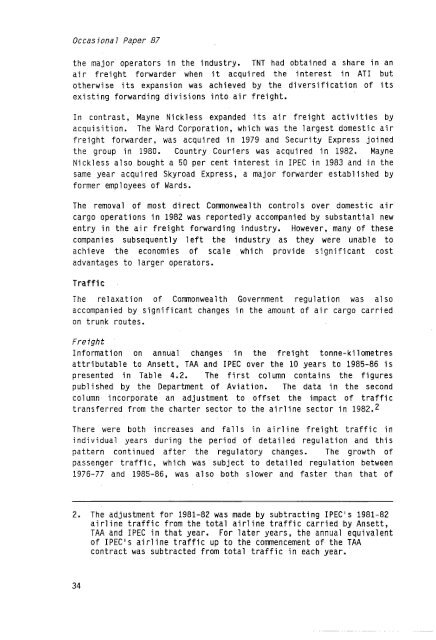Domestic Air Cargo Industry in Australia - Bureau of Infrastructure ...
Domestic Air Cargo Industry in Australia - Bureau of Infrastructure ...
Domestic Air Cargo Industry in Australia - Bureau of Infrastructure ...
You also want an ePaper? Increase the reach of your titles
YUMPU automatically turns print PDFs into web optimized ePapers that Google loves.
Occasional Paper 87the major operators <strong>in</strong> the <strong>in</strong>dustry. TNT had obta<strong>in</strong>ed a share <strong>in</strong> anair freight forwarder when it acquired the <strong>in</strong>terest <strong>in</strong> AT1 butotherwise its expansion was achieved by the diversification <strong>of</strong> itsexist<strong>in</strong>g forward<strong>in</strong>g divisions <strong>in</strong>to air freight.In contrast, Mayne Nickless expanded its air freight activitiesbyacquisition. The Ward Corporation, which was the largest domestic airfreight forwarder, was acquired <strong>in</strong> 1979 and Security Express jo<strong>in</strong>edthe group <strong>in</strong> 1980. Country Couriers was acquired <strong>in</strong> 1982. MayneNickless also bought a 50 per cent <strong>in</strong>terest <strong>in</strong> IPEC <strong>in</strong> 1983 and <strong>in</strong> thesame year acquired Skyroad Express, a major forwarder established byformer employees <strong>of</strong> Wards.The removal <strong>of</strong> most direct Cornonwealth controls over domestic aircargo operations <strong>in</strong> 1982 was reportedly accompanied by substantial newentry <strong>in</strong> the air freight forward<strong>in</strong>g <strong>in</strong>dustry. However, many <strong>of</strong> thesecompanies subsequently left the <strong>in</strong>dustry as they were unable toachieve the economies <strong>of</strong> scale which provide significant costadvantages to larger operators.Traf f i cThe relaxation <strong>of</strong> Cornonwealth Government regulation was alsoaccompanied by significant changes <strong>in</strong> the amount <strong>of</strong> air cargo carriedon trunk routes.Fre igh tInformation on annual changes <strong>in</strong> the freight tonne-kilometresattributable to Ansett, TAA and IPEC over the 10 years to 1985-86 ispresented <strong>in</strong> Table 4.2. The first column conta<strong>in</strong>s the figurespublished by the Department <strong>of</strong> Aviation. The data<strong>in</strong> the secondcolumn <strong>in</strong>corporate an adjustment to <strong>of</strong>fset the impact <strong>of</strong> traffictransferred from the charter sector to the airl<strong>in</strong>e sector <strong>in</strong> 1982.2There were both <strong>in</strong>creases and falls <strong>in</strong> airl<strong>in</strong>e freight traffic <strong>in</strong><strong>in</strong>dividual years dur<strong>in</strong>g the period <strong>of</strong> detailed regulation and thispattern cont<strong>in</strong>ued after the regulatory changes. The growth <strong>of</strong>passenger traffic, which was subject to detailed regulation between1976-77 and 1985-86, was also both slower and faster than that <strong>of</strong>2. The adjustment for 1981-82 was made by subtract<strong>in</strong>g IPEC's 1981-82airl<strong>in</strong>e traffic from the total airl<strong>in</strong>e traffic carried by Ansett,TAA and IPEC <strong>in</strong> that year. For later years, the annual equivalent<strong>of</strong> IPEC's airl<strong>in</strong>e traffic up to the comnencement <strong>of</strong> the TAAcontract was subtracted from total traffic <strong>in</strong> each year.34
















